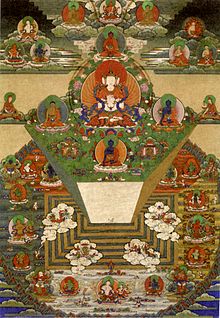
Back Meru Afrikaans جبل ميرو Arabic Меру (митология) Bulgarian মেরু পর্বত Bengali/Bangla Planina Meru BS Mont Meru Catalan Méru Czech Meru Danish Meru (Mythologie) German Monto Meruo Esperanto

Mount Meru (Sanskrit/Pali: मेरु), also known as Sumeru, Sineru, or Mahāmeru, is the sacred five-peaked mountain of Hindu, Jain, and Buddhist cosmology and is considered to be the centre of all the physical, metaphysical, and spiritual universes.[1] The mountain is also mentioned in some scriptures of non-Indian based religions such as Taoism, which was influenced by the arrival of Buddhism in China.[2] There is no clear identification of Mount Meru with a particular geophysical location but it is always located in Himalayan or Aravali ranges.
Many famous Hindu, Jain, and Buddhist temples have been built as symbolic representations of this mountain. The "Sumeru Throne" 須彌座 xūmízuò style base is a common feature[citation needed] of Chinese pagodas. The highest point (the finial bud) on the pyatthat, a Burmese-style multi-tiered roof, represents Mount Meru.
- ^ Gopal, Madan (1990). K.S. Gautam (ed.). India through the ages. Publication Division, Ministry of Information and Broadcasting, Government of India. p. 78.
- ^ "THƯỢNG THẤT TIÊU TAI TẬP PHÚC DIỆU KINH". thegioivohinh.com. Retrieved 8 March 2023.
© MMXXIII Rich X Search. We shall prevail. All rights reserved. Rich X Search